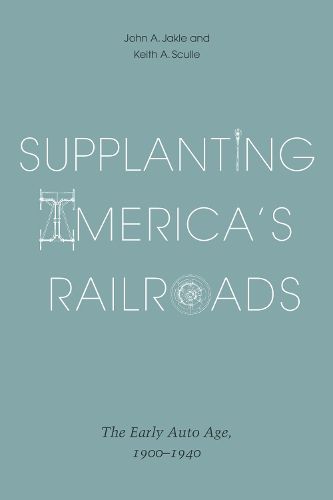Readings Newsletter
Become a Readings Member to make your shopping experience even easier.
Sign in or sign up for free!
You’re not far away from qualifying for FREE standard shipping within Australia
You’ve qualified for FREE standard shipping within Australia
The cart is loading…






With their speed and geographical reach, America’s railroads reigned supreme through much of the nineteenth century, knitting together the sprawling country as no other mode of transportation was able to do. Around 1900, however, an upstart challenger-the automobile- arrived on the scene. At first regarded as little more than a plaything for the wealthy, the new invention rapidly gained popularity, especially after Henry Ford’s innovative mass-production techniques made cars affordable to the middling classes.
In this engaging book, John A. Jakle and Keith A. Sculle-renowned experts on the wide-ranging effects of automobility on American life-examine the various ways in which the railroads responded to their new competition, not just from the automobile itself but from its close cousins, the motor truck and motor bus, through several decades up to the eve of World War II. Drawing on extensive research in the trade publications of the period, the authors examine the development of interurban and intraurban rail transport, the transition from steam to electric and diesel power, and the railroads’ close involvement in the nascent trucking and passenger-bus industries. They devote a chapter to the places where trains and automobiles came most directly and dangerously into conflict-railroad crossings-and pay special attention throughout to the key role of government in the competition, whether through antitrust legislation, taxation, or the building of the good roads that were so necessary to the rise of auto, truck, and bus transport.
Although the railroads remain with us, it was the automobile that emerged as the predominant transportation form, owing to its promise of speed, convenience, flexibility of movement, and, most important, self-gratification. In a country that places such high value on individual freedom, the romance of motoring has proven irresistible.
$9.00 standard shipping within Australia
FREE standard shipping within Australia for orders over $100.00
Express & International shipping calculated at checkout
With their speed and geographical reach, America’s railroads reigned supreme through much of the nineteenth century, knitting together the sprawling country as no other mode of transportation was able to do. Around 1900, however, an upstart challenger-the automobile- arrived on the scene. At first regarded as little more than a plaything for the wealthy, the new invention rapidly gained popularity, especially after Henry Ford’s innovative mass-production techniques made cars affordable to the middling classes.
In this engaging book, John A. Jakle and Keith A. Sculle-renowned experts on the wide-ranging effects of automobility on American life-examine the various ways in which the railroads responded to their new competition, not just from the automobile itself but from its close cousins, the motor truck and motor bus, through several decades up to the eve of World War II. Drawing on extensive research in the trade publications of the period, the authors examine the development of interurban and intraurban rail transport, the transition from steam to electric and diesel power, and the railroads’ close involvement in the nascent trucking and passenger-bus industries. They devote a chapter to the places where trains and automobiles came most directly and dangerously into conflict-railroad crossings-and pay special attention throughout to the key role of government in the competition, whether through antitrust legislation, taxation, or the building of the good roads that were so necessary to the rise of auto, truck, and bus transport.
Although the railroads remain with us, it was the automobile that emerged as the predominant transportation form, owing to its promise of speed, convenience, flexibility of movement, and, most important, self-gratification. In a country that places such high value on individual freedom, the romance of motoring has proven irresistible.